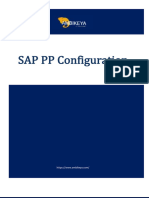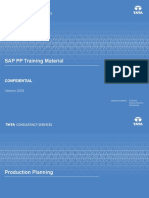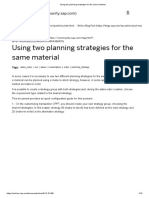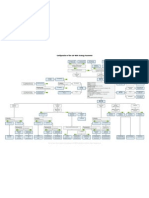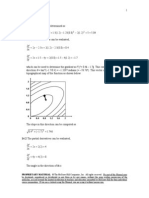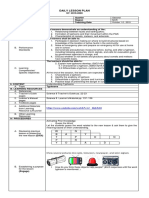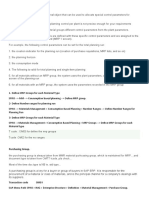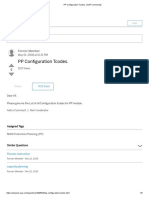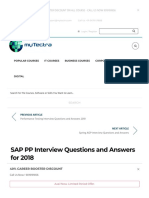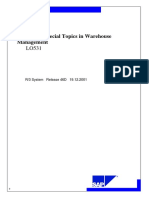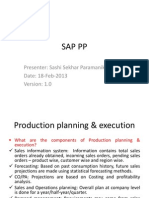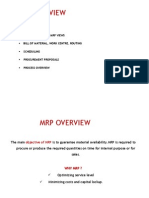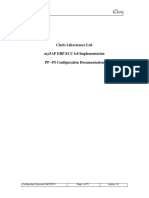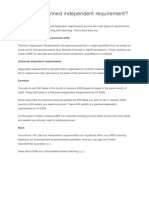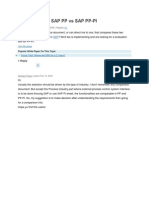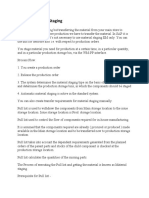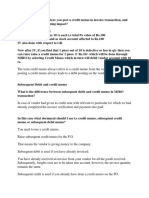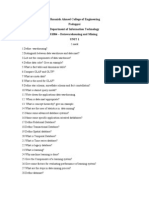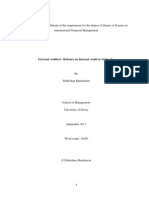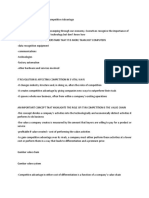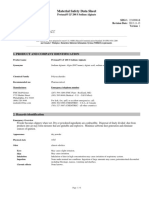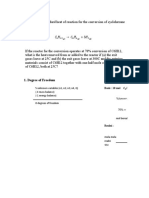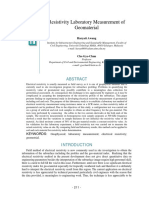MRP
MRP
Uploaded by
RAMAKRISHNA.GCopyright:
Available Formats
MRP
MRP
Uploaded by
RAMAKRISHNA.GOriginal Title
Copyright
Available Formats
Share this document
Did you find this document useful?
Is this content inappropriate?
Copyright:
Available Formats
MRP
MRP
Uploaded by
RAMAKRISHNA.GCopyright:
Available Formats
SAPs'WORD - We SAP For Your Cause
Home Choosing SAP as a career SAP MRP SAP PP / PPPI SAP Batch Management and Classification System Join as Member Donations SAP Links & Websites SAP Education Sitemap Home SAP PP / PPPI SAP MRP
SAP MRP Configuration
Study Material Contributed by Ulhas Kavle - Senior SAP Consultant, Mahindra Satyam
Next Step >>> Creation of Material Master MRP Views and Assignment of MRP Types
SAP MRP Configuration SAP MRP Configuration The following are the Major Configuration items explained in detail: a) Activating MRP and Planning File Entry b) SAP MRP Plant Level MRP Parameters Configuration c) SAP MRP, MRP Group Level Parameters Configuration d) Configuring SAP MRP Types e) Configuring SAP MRP Scope of Planning for the Total Planning Run f) Configuring SAP MRP Planning time fence and Roll Forward Period g) Configuring SAP MRP Areas h) SAP MRP Dynamic Safety Stock (Range of coverage Profile) i) Configuring SAP MRP Days Supply and Receipt Days Supply
SAP MRP Configuration
Activating MRP and Planning File Entry
a) Activating SAP's Material Requirements Planning (MRP)
This configuration allows you to choose the plant for which you would want to activate SAP M the SAP MRP tool for the plant. SAP Transaction code OMDU and the SAP path is Logistics >
b) Activating Planning File Entries for a Plant
Activating Planning file entry for the plant (through a variant that can be rescheduled) allows y master MRP 1 View (other than MRP Type XO)
The process of recording a planning file entry for a material, can be run periodically using a ba OMDO and the Path for activating the planning file set up is Logistics > Production > MRP >
All the entries in the planning file will have a change indicator specifying that a material has you to choose only those materials that have undergone a change, through the use of planning k
The planning file record for a material also has a net change planning in the current horizon planning horizon. This indicator will help you choose only those materials which have undergo Net change planning in the planning horizon.
Plant Level configuration for MRP Plant Level configuration for MRP
SAP MRP is run at plant level or at a group of plant level (called as scope of planning), thus th
The configuration done for SAP MRP at Plant level would also be true for SAP Consumption B
Transaction code OPPQ takes you in to the SAP MRP configuration called as Plant Paramete > Material Requirement Planning > Plant Parameters > Carry out Overall Maintenance of Plan
The Transaction code for Consumption Based planning is OMI8 and the Path is Logistics > Ma Maintenance of Plant Parameters.
Fig MRP - Config 1
In the transaction code for Plant level parameters for SAP MRP, you should first input the plan
If you have already maintained the configuration for the parameters, then it states so, if you hav
Fig MRP - Config 2
Following are the parameters that need to maintain as a part of SAP MRP/CBP Configuration:
a) Number ranges The number range IDs are maintained for the following objects: the Planned orders the reservations, the dependent requirements, the simulative dependent requirements, the purchase requisitions, the MRP Lists,
In this section only the number range IDs are maintained. While the actual number range is co objects created in the planning run). One can also use the transaction code OMI3 for the object
Every number range interval, created using OMI2 and OM13, has an ID, which can be allocate objects mentioned above.
b) Availability Check rule for Backorder Processing
As per standard SAP, the Availability checking rule for the backorder processing is PP, thou
Every Availability checks rule (availability checking scope defined) has a set of receipts (Purch planned independent requirements etc) which are to be considered or not to be considered durin
To have the checking rule work along with the configuration, you should have the Availability associated with the checking rules (checking scopes).
The availability checking rule (checking rule scope) has to be maintained, for a given SAP fun material master. The SAP functionalities that use availability checks to check the availability o the availability checks of the header material at the time of sales order delivery, the availability processing etc.
c) Reporting This configuration is used for the following purposes.
To configure the objects, which are to be considered in the calculation of the receipts orders, assigned planned orders, firmed purchase requisitions, QM Inspection lots, reservat To configure the reporting of periods totals in terms of a defined period (day, week, MPR or interactive MRP
d) MRP Controllers
This is a mandatory configuration. Here you can configure the list of MRP controllers for the p material or a given list of materials.
You have to assign the MRP controller to the Material Master MRP 1 View, so as to delegate t
e) Floats Floats are buffers in the total lead time, that are provided in production/process order or in the the Material Master MRP 2 View. It is used in MRP as well as in production order. The floats are defined using the scheduling margin key.
Opening period: Number of working days between the date that the order is created and the pla purchase requisition or a production order.
Float after production: Number of working days between the scheduled finish date and the ord
Float before production: Number of working days between the order start date and the schedul
Scheduling release period: Number of workdays between the planned start date and the date fo background program that takes all dates into account.
Plant 0001 0001 0001
Plant Name 0001 0001 0001
Margin Key 001 002 002
Opening Period (In Days) 5 5 5
Fl. Before Production (In Days) 2 3 4
f) Special Procurement
The special procurement function helps you to configure and assign special procurement to the
The special procurement functions are withdrawal from alternate plant, production in alternate
https://sites.google.com/site/sapswords/home/learn-sap-pp/sap-material-master/sap-mrp2-view Example: For Stock Transfer from Plant C001 to Plant C002
Create the Special procurement key (Key number = 12 as an example) in the plant C002 with t procurement plant as C001. Normally when creating the special procurement key use Z, Y o Z2 or YA etc.
Fig MRP - Config 3
Similarly for Withdrawal from Alternate plant, you could have a Configuration as below:
Fig MRP - Config 4
Similarly for Subcontracting, you could have a Configuration as below:
Fig MRP - Config 5
Similarly for Production in alternate plant, you could have a Configuration as below:
Fig MRP - Config 6
g) Conversion for Planned orders
In this configuration parameter, you can maintain the production order type or the process orde defaults in the plant parameters configuration allows the system to fix and select the order type Note: This can be a useful tool when you are using one production order type and one process
be maintaining defaults here.
Also for the purchase requisition conversion, you are given an option in the configuration to de
Fig MRP - Config 7
g) Dependent Requirements availability check
When carrying out the availability check for each of the components in a MRP BOM explosion standard Checking rule as PP or you could alternatively configure one for yourselves.
h) BOM/Routing Selection ID
This configuration parameter is really important and it is mandatory to maintain one, since it he the planned order Scheduling parameters MRP configuration, where you can maintain the selec
A selection procedure is set to select BOM or Routing/Recipe on priorities set for the BOM usa the MRP run to select the right BOM and task list for the planned orders.
In other words, you could have the BOM Selection being set for selection of the Production BO found, you could have the system search for a BOM of universal Usage (Usage = 3).
Similarly, you could have a task list of type Routing or Recipe or reference operation sets selec has a Status Released for all purposes or released for costing) etc.
h) Scheduling of Planned orders
This configuration parameter is really important and it is mandatory to maintain one. It allows and for a given MRP Controller. You can leave the MRP controller as * to have the scheduli The following control parameters can be configured here:
The Routing/Recipe Selection ID, specifying the routing/recipe that would be selected
The Detailed scheduling, using the task list is only carried for the scheduling Horizon date scheduling is used where the in house production times from the material master is use
Allow Scheduling Indicator allows the planned orders to be scheduled using the detail the task list and scheduling type selected for the MRP run.
Generate Capacity requirements indicator allows generation of the capacity requireme the use of the work center determined through the scheduling carried out.
The Task list selection, scheduling horizon, scheduling indicator and the capacity indic
The next configuration parameter talks about the configuration of the selection of the t The various options available are rate based scheduling, lead time scheduling, scheduling u
The Adjust planned order dates configuration option allows you to readjust the schedu scheduling configuration option provided by the system for overwriting/adjusting the existi mentioned). The system not only offers an option to adjust the basic dates for the planned order arrived to the operation start date or the order start date.
This configuration not only adjusts or sets the dates of the header planned order and the dep
See below for the details of adjusting dates in scheduling and adjusting dates for capacity r
You can adjust the Basic Dates of the header planned order using the schedulin
You can adjust the Basic Dates of the header planned order using the schedulin to which the dependent requirements are assigned to
You can decide not to adjust the Basic Dates of the header planned order arrive requirements to the start of the header planned order
You can decide not to adjust the Basic Dates of the header planned order arrive requirements to the start of the respective operations to which the dependent require
You are also provided an option to configure the scheduling type whether forward o as backward scheduling so that SAP MRP (material requirement planning) never misses schedule, any orders during the breaks set in the factory calendar.
Start date in the in the past options allows you to push the start date of the planned or allowed, then the system uses the concept of todays scheduling and sets the start date of
One of the scheduling parameters is reduction measures, used to reduce the total ord you are not using it.
Fig MRP - Config 8
i) Default Values for External Processing
For external purchasing, one can maintain the default lead time required for conversion of Purc info record or purchasing agreement. So as to use the planned delivery times from the purchase the source list and the purchase info record.
Using the planned delivery times from the material master or from purchase info record, is tota using the lead time from info records.
j) Planning Horizon
Maintaining a planning horizon helps the system to plan only those demands, which fall in the number of work days as mentioned (lets say 180 days) from todays date; the system would no
k) Available stock for net requirement calculations
SAP MRP offers you a choice to select the most controversial stock types, in its net requiremen at the receiving plant as it is already issued from the sending plant), blocked stock, restricted b
Fig MRP - Config 9
l) Option to trigger direct Production in MRP or in production planning
j) Allowing start date in the past
MRP Group Level configuration for MRP MRP Group Level configuration for MRP
The entire configuration that is created as a part of SAP MRP Plant level parameter in the abov of the MRP Group can have its own MRP Parameter set. You can set the MRP group in the ma
MRP Group can be maintained using transaction code OPPR or the transaction path Logistic Advantage of working with MRP Groups:
Working with MRP groups can be convenient for a plant or an organization, since by assigning (through MRP Groups) to behave in a certain manner for planning purposes. In other words, al features. Thus the organization can device multiple MRP groups with their own planning featu The group could have its own unique: Strategy group, Conversion order types, Planning horizon, Planning time fence and roll forward periods, BOM and task list selection IDs, Direct procurement parameters, Planned order scheduling parameters, Start number of days allowed in the past Availability checking groups,
Strategy Groups
The strategy groups can be set for a given MRP group at a given plant. The strategy group con the strategy groups, groups together the relevant planning strategies of a material. If you dont on the materials MRP 3 view. Defaulting the strategy groups is a nice idea when the strategy g strategy group. For example:
A material can have the priority 1 strategy as Made-to-Stock (planning strategy 40) and then pr group for a MRP group in the MRP Group Parameters configuration and then subsequently as
strategy 40 and planning strategy 20 in a sequence of priority.
The primary strategy for the material is 40 Made-to-stock while the secondary strategy is 20 order for the material it will always primarily work as a made-to-stock material. Nevertheless, type KE of the material in the sales order procurement tab, to suit for made-to-order, which
Configuring SAP MRP Types Configuration of SAP MRP Types
In all probabilities, MRP Types is not something which one should configure in SAP; it is used types and the involved pre-configured parameters.
Fig MRP - Config 10
a) MRP Procedures
MRP Procedures defines the type of MRP to be used Reorder point planning methods, Mater methods, Time phased planning methods, MPS and the no planning procedures to mark a mate
b) Firming Type In the category of MRP procedure called MRP or demand based planning method and MPS, M4.
When working with the planning time fence, one needs to set the firming methods & the sched
0 Firming type M0 MRP Types
Firming Methods for Procurement Proposals in the Planning time fence No Firming of Procurement Proposals within the planning time fence Automatic Firming of Procurement Proposals within the planning time fence Manual Firming of Procurement within the planning time fence (No Automatic Firming of the procurement proposals ) X
Treatment with New Order Proposals in the Planning time Fence Automatic Creation of New Procurement Proposals to cover the shortages within the planning time fence. But the dates of these new Procurement Proposals are pushed outside the planning time fence No New Procurement Proposals created to Cover the material shortages within the planning time fence
c) Include External Requirements
The inclusion of external requirements in net requirement calculations is available to be set, wh options in this field, i.e., include external requirements in the total planning horizon or restrict For example:
If the external requirements are set to be considered in the total horizon (of 7 weeks) then in th and it will reduce the warehouse stock proportionately which would trigger the reorder point pl
If the external requirements are set to be considered in the Replenishment lead time, lets say th before the start date of the external demand, this customer demand will be considered, thus trig
Fig MRP - Config 11
SAP also offers an option to select the additional external requirements that should also be incl vendor in a subcontracting case, reservations set for the components in a production order, rese order to another plant, stock transfer requisitions created for Stock transfer orders, requirement
c) Forecasting for MRP
Forecasting MRP Types have a forecasting indicator as obligatory, unlike other MRP types w
Also the historical data is updated in the material master as total consumption (planned consum planned as per the MRP reservations, planned consumption is updated and when the consumpt unplanned consumption is updated.
In MRP type configuration, you have an option of choosing the type of historical consumption consumption) or unplanned consumption.
After choosing the historical date type, you should configure, the type of forecast requirements consumption) or unplanned consumption.
The reduction method for forecast requirements is also configurable. The default is reduction b
d) Planning method
The MRP type offers you to plan the materials in an external system, like the MRP Type X0. T materials in the external system.
e) Automatic Calculations
You can have the safety stock and the reorder point calculated automatically by the system, wh the system uses the forecast data.
Configuring SAP MRP Scope of Planning for the Total Planning Run Configuring SAP MRP Scope of Planning for the Total Planning Run
SAP provides an option to plan multiple plants together or multiple MRP areas in one planning path SAP Customizing Implementation Guide > Production > MRP > Planning > Define Sco Step 1 Define the Name of the Scope of planning run
Step 2 Define the plants or MRP areas to be included in the planning run arranged in a seque
Configuring SAP MRP Planning time fence and Roll Forward Period Configuring SAP MRP Planning time fence and Roll Forward Period
The transaction path to configure the planning time fence and roll forward period is: SAP Cust MRP Areas > MRP Calculation > Define Planning Time Fence and Roll Forward Period
Planning Time Fence:
The planning time fence is the number of work days, within which you can protect the master p changed from any automatic changes (of an MRP Run). The procurement proposals are firmed orders, purchase requisitions, delivery schedules) in the planning time fence prevents the propo
In other words, in the planning time fence, the system does not create or delete any procuremen
The system calculates the time fence from todays date plus the number of days mentioned as define the planning time fence for plant or for a given MRP group). It is needless to say that an changed. MRP carries its usual planning outside this fence without interrupting this fenced per
Configure Planning Time fence and Roll Forward Period Plant 0001 0001 MRP Group 0001 0002
Plannin 14 14
It is logical that any procurement proposal lying outside this fence would start moving in to the fence, they are automatically firmed for protection. Firming for automatically created procurement proposals:
The automatically created procurement proposals in the MRP Run are not firmed by the system where there is change in BOM or task list.
You can though manually firm the planned orders individually or collectively using transaction
Note - Automatically created planned orders in the planning time fence are only remain firm ti
Firming for manually created procurement proposals:
For manually created or changed procurement proposals or even when you reschedule the plan indicator. Though you can remove or delete this firming indicator.
Firming for components planned orders:
In case of a planned order, you can manually firm it by selecting the firming planned order In not exploded or changed in a planning run, you have to set the firming components indicator See the below Example Planning time fence is 3 days.
Planning Start Date Today Day 1 Day 2 Planning time fence Planned Order 1 Planned Order 2 Auto Firmed Auto Firmed
Day 3 Planned Order 3 Auto Firmed
Day 4 Planned Order 4 Not-firmed Next Planning Start Date Planning time fence Planned Order 4 Auto Firmed
Da
Pla Fir
Pla Au
Roll Forward Period
The Roll Forward Period adds the functionality of automatic deletion of firmed planned orders the MRP run. This period can be defined for number of days in past or future. The system dele
Using the roll forward period, you can have the system delete all useless old firmed planned or allows for reorganizing the planned orders.
Configuring SAP MRP Areas Configuring SAP MRP Areas
Long ago, SAP MRP was only at the plant level or at MRP controller level (activated through a define your own area for which you want to run MRP without disturbing other areas.
Running MRP for MRP Areas: For running MRP at a MRP area, you would have to create a arranged in sequence of planning.
Assigning MRP areas: To have the MRP Areas work, you have to activate the MRP areas a is not assigned to the material, then it will work as per the plant level MRP area.
Configuring MRP areas
Step 1: Activate MRP Area: Use the transaction path: SAP Customizing Implementation Guid MRP for MRP Areas
Step 2: Define MRP Areas: Use transaction path: SAP Customizing Implementation Guide > P Areas
Types of MRP Areas:
Plant MRP Areas: You can create one MRP area for several plants, so that when you run the M
Storage Location MRP Areas: You can create MRP areas for several storage locations at a plan
Subcontractors MRP Areas: You can create MRP areas for several subcontractors for a plant. Y
Configuring SAP MRP Dynamic Safety Stock (Range of coverage Pro Configuring SAP MRP Dynamic Safety Stock (Range of coverage Profile)
The Range of coverage profile is configured for the use of Dynamic safety stock for a given m dynamic safety stock. The dynamic safety stock is a stock calculated based on the average dail more statistical value rather than an absolute value.
Safety stock as we know is used to cover the fluctuations in the requirements, so is the dynami for a material whereas the dynamic safety stock is calculated by the system on the basis of the The Dynamic safety stock is calculated in every planning run.
The transaction path is: SAP Customizing Implementation Guide > Production > Material Req (Dynamic Safety Stock) Range of coverage Configuration:
Fig MRP - Config 12
Configuration for calculation of average daily requirement for a period
Period indicator - Indicate the type of period, whether week or month or according to PP plann
Number of Periods Number of periods used to calculate the average daily requirements (Let
Type of Period length It defines the number of days in the period, if the period length is in te terms of calendar days then it is considered in terms of Gregorian calendar, and if it is terms of configuration (Lets say that the configuration was done with workdays and the factory calenda Therefore Average daily requirement =
= Requirements in the period (Requirements in 13 Weeks Lets say 910 Units) / (Number of P = 910 / (13*7) = 10 Units
Configuration parameters for calculation of Dynamic Safety Stock for the Range of Coverag
You can define 3 different range of coverage minimum, maximum, and target range of cover of coverage multiplied by the period length). The Target range of coverage defined here would
The Period of the coverage is specified in the configuration. The coverages and the periods fo length is for the rest of horizon. In the example, we have defined the safety stock to cover a period of 7 days (minimum, target calculated for the average daily requirement over the respective coverage periods.
You can check the minimum, maximum, target stock levels, minimum range of coverage, max lists Period Total Display Section.
As per our example, for the first period of 13 weeks, all the 3 stocks levels minimum, maxim units as well and for the rest of the horizon it will be 70 units again.
Normally when the available stock falls below the minimum stock level, SAP planning run, wo the minimum stock level is 30 and the maximum is 80 and the target stock is 50 units, then if th units to reach back to the target stock level. Whereas in the example below, all the 3 stocks typ procurement proposal to reach back to 70 units. As per our example in the configuration screen shot
Dynamic safety stock formula summarized as = Average Daily Stock * Range of coverage
Dynamic safety stocks for the 1st period of 13 weeks
70 Units Minimum safety stock 70 Units Target safety stock 70 Units Maximum safety stock
Another Example of Dynamic Safety Stock
Fig MRP - Config 14
Step a) Demand for 8 Weeks = 800 Step b) Average Daily Requirements = 896 Units of Demand for 8 Weeks / (8Weeks * 7 Days Per Week) = 896/(8*7) = 896/56 = 16 Units Step c) Calculation of Safety Stock for the coverage period As per our example in the configuration screen shot
For the first period, when the stock falls below 32 units (minimum Stock Level), the SAP MRP suffice at least the target safety stock level or the dynamic safety stock level = 8 Units.
Dynamic safety stock formula summarized as = Average Daily Stock * Range of coverage
Dynamic safety stocks for the 1st period of 8 weeks = 2 * 16 = 32
D 8
Minimum safety stock = 5 * 16 = 80 Target safety stock
= 7 * 16 = 112 Maximum safety stock
Configuring SAP MRP Day's Supply and Receipt Day's Supply Configuring SAP MRP Day's Supply and Receipt Day's Supply
The days of supply is not a mandatory configuration, you can only configure the days supply if SAP offers 2 types of evaluations in SAP, the days supply and the receipt days supply.
In the SAP MRP Evaluation transactions such as stock requirement list or MRP list, the days s be satisfied purely by the current available stock.
While the Receipt Days supply would indicate how long would the current stock and the expe offered by SAP called as the receipt days supply 1 and receipt days supply 2. SAP offers a con also an option to have the receipt days supplies to be calculated when the stocks fall below the
The days supply values or the receipt days supply values can be correlated with the range of co warnings to the MRP Controllers/users and lets him/her strategically know when the material s necessary actions in advance.
The transaction path for the same is SAP Customizing Implementation Guide > Production > M Supply
Fig MRP - Config 13
Number of Days Stocks will Cover the Requirements
Consider Current Stocks only in calculation of Days Supply
Only Consider Current available Stocks to cover Requirements
Consider Receipts also along with Current Stock in Calculation of Days Supply
Firmed Planned orders, Planned orders assigned with Production versions, Purchase orders, Sched
Consider all the possible receipt elements along with the plant stock
Example Firmed Planned orders, Planned orders assigned with Production versions, Purchase orde Schedule lines, Firmed Purchase Requisitions, Receipt Reservations,
Consider all the Most Certain receipt elements along with the plant stock Example - Production order, Shipping Notifications, QM Inspection Lots
Example for Days Supply and Receipt Days Supply:
Days Supply for Material M1 on Today = 3 days (Receipts are not considered) Day Requirements Available Qty
Today 2nd Day 3rd Day
20 30 50
Current Stock = 100 Stock Available = 80 Stock Available = 50
4th Day 5th Day 6th Day
52 40 20
Days Supply on Today = Coverages Considering without the receipts = 3 Days Exactly
Receipts Days Supply for Material M1 on Today = A little more than 4 days (Receipts are also considered This example can be for Receipt Days supply 1 or 2) Day Reqmts Expected Receipts
Today
20 Firmed Planned order = 10 Production order = 5 Total Receipts on day = 15
2nd Day
30 Total Receipts on day = 0
3rd Day
50 Production order = 25 Total Receipts on day = 25
4th Day
47 Planned order = 8 Production order = 5 Total Receipts on day = 13
5th Day
40 Planned order = 5 Total Receipts on day = 0
6th Day
20
Receipt Days Supply on Today = Coverages Considering the receipts = 5 1 + (6/40) = 4 + 0.15 = 4.15 Days
Next Step >>> Creation of Material Master MRP Views and Assignment of MRP Types
All the site contents are Copyright www.sapsword.com and the content authors. All rights rese All product names are trademarks of their respective companies. The site www.sapsword.com is Information used on this site is at your own risk. The content on this site may not be reproduced or redistributed without the express written perm www.sapsword.com or the content authors. Sitemap
Sign in Recent Site Activity Revision History Terms Report Abuse Powered by Google Sites
You might also like
- SAP PP ConfigurationDocument49 pagesSAP PP ConfigurationEugene100% (1)
- The God Particle PDFDocument8 pagesThe God Particle PDFSabrina PB100% (1)
- SAP PP ConfiDocument64 pagesSAP PP ConfiVy Nguyễn TườngNo ratings yet
- Sap PP Production Planning MRP OverviewDocument36 pagesSap PP Production Planning MRP OverviewsameeNo ratings yet
- Purchase Order - Test ScriptDocument14 pagesPurchase Order - Test ScriptRAMAKRISHNA.GNo ratings yet
- Purchase Order - Test ScriptDocument14 pagesPurchase Order - Test ScriptRAMAKRISHNA.GNo ratings yet
- Purchase Requesition Test ScriptDocument14 pagesPurchase Requesition Test ScriptRAMAKRISHNA.GNo ratings yet
- Implementing Integrated Business Planning: A Guide Exemplified With Process Context and SAP IBP Use CasesFrom EverandImplementing Integrated Business Planning: A Guide Exemplified With Process Context and SAP IBP Use CasesNo ratings yet
- Using Two Planning Strategies For The Same MaterialDocument10 pagesUsing Two Planning Strategies For The Same MaterialVigneshNo ratings yet
- SAP MRP Strategy ParameterDocument1 pageSAP MRP Strategy ParameterJagan KilariNo ratings yet
- Source List Test ScriptDocument5 pagesSource List Test ScriptRAMAKRISHNA.GNo ratings yet
- KOHLER - MPAC1000 Setup ProgramDocument52 pagesKOHLER - MPAC1000 Setup ProgramalstomNo ratings yet
- On Philosophical Style by Brand BlandshardDocument17 pagesOn Philosophical Style by Brand Blandshardenieves78100% (1)
- People, Job and OrganizationDocument40 pagesPeople, Job and OrganizationJedNur KusayinNo ratings yet
- Numerical Method For Engineers-Chapter 14Document8 pagesNumerical Method For Engineers-Chapter 14MrbudakbaekNo ratings yet
- DLP TyphoonsDocument4 pagesDLP Typhoonsamie80% (5)
- Sap MRP ConfigurationDocument31 pagesSap MRP ConfigurationtoralberNo ratings yet
- PP Material MasterDocument30 pagesPP Material Mastermorya19No ratings yet
- Opening Period For Backward SchedulingDocument21 pagesOpening Period For Backward SchedulingdontmailNo ratings yet
- Sap MRP ConfigDocument23 pagesSap MRP Configsharadapurv100% (1)
- Sap MRP Configuration PPDocument27 pagesSap MRP Configuration PPKidana TestNo ratings yet
- PP Configuration Tcodes. - SAP CommunityDocument5 pagesPP Configuration Tcodes. - SAP CommunitySravan KumarNo ratings yet
- L6 Sap Production Planning ModuleDocument37 pagesL6 Sap Production Planning ModuleRajat Shetty100% (1)
- SAP MRP ConfigurationDocument32 pagesSAP MRP ConfigurationJames BondNo ratings yet
- Sap PP Configuration DocumentDocument75 pagesSap PP Configuration DocumentRafaelCasagrandeNo ratings yet
- MRP Overview ScribdDocument50 pagesMRP Overview Scribdh_kobi76100% (1)
- SAP Capacity Planning - Pool CapacityDocument42 pagesSAP Capacity Planning - Pool CapacityArya RagNo ratings yet
- Configuration Guide To Create Organizational Structures in Sap MMDocument17 pagesConfiguration Guide To Create Organizational Structures in Sap MMrakesh_sapNo ratings yet
- PP QuestionarrieDocument21 pagesPP QuestionarrienarkarmsNo ratings yet
- Explanation On Work Center in SAP PPDocument49 pagesExplanation On Work Center in SAP PPB.n. TiwariNo ratings yet
- SAP PP 30 Interview Questions and Answers For 2018Document18 pagesSAP PP 30 Interview Questions and Answers For 2018Hemamber ReddyNo ratings yet
- Can MRP Be Carried Out For One Particular Level of A BomDocument10 pagesCan MRP Be Carried Out For One Particular Level of A BomVipul ShuklaNo ratings yet
- SAP PP - Common Tables: For Material Requirement PlanningDocument2 pagesSAP PP - Common Tables: For Material Requirement Planningchandra9000No ratings yet
- Engineering Change Management: SAP PP TablesDocument2 pagesEngineering Change Management: SAP PP TablesartwaniparasNo ratings yet
- Lo531 PDFDocument173 pagesLo531 PDFannasunilkumar3437No ratings yet
- Sap PPDocument21 pagesSap PPTaniya Jain0% (1)
- Backflush and Its Priority in Use - SAP BlogsDocument7 pagesBackflush and Its Priority in Use - SAP BlogsnabigcsNo ratings yet
- 4 - Schedule MRP Runs PDFDocument9 pages4 - Schedule MRP Runs PDFAmruta RaneNo ratings yet
- SAP REM Full Cycle Scenario With Basic Step: CommunityDocument27 pagesSAP REM Full Cycle Scenario With Basic Step: CommunityVigneshNo ratings yet
- Technical Information On How The Planning Run Works: ContentsDocument50 pagesTechnical Information On How The Planning Run Works: ContentsMárcio NascimentoNo ratings yet
- SAP PP OverviewDocument10 pagesSAP PP OverviewjayakumargjNo ratings yet
- PPDS PresentationDocument37 pagesPPDS Presentationakshay KumarNo ratings yet
- JD - SAP PP QM (Manufacturing)Document2 pagesJD - SAP PP QM (Manufacturing)Nitin100% (1)
- Configuration Document SAP PP PI mySAP E PDFDocument75 pagesConfiguration Document SAP PP PI mySAP E PDFibrahimNo ratings yet
- What Is A Planned IndependentDocument8 pagesWhat Is A Planned IndependentRizwan SiddiquiNo ratings yet
- CO24-Missing Parts Info System-Ecc6 PDFDocument11 pagesCO24-Missing Parts Info System-Ecc6 PDFBhaskar BiswasNo ratings yet
- MRP - Tutorial SAPDocument12 pagesMRP - Tutorial SAPTatiane Garcia100% (1)
- SAP MRP 2 ViewDocument7 pagesSAP MRP 2 ViewVivek Malik100% (1)
- Create Material Master MRP Views and Assign MRP TypesDocument12 pagesCreate Material Master MRP Views and Assign MRP Typesdudhmogre23No ratings yet
- PP ManualDocument4 pagesPP ManualharibabuNo ratings yet
- Milestone Confirmation of The Process Order With Multiple Operations & With Multiple Phases Involved - SAP BlogsDocument18 pagesMilestone Confirmation of The Process Order With Multiple Operations & With Multiple Phases Involved - SAP BlogsRaghNo ratings yet
- Batch DeterminationDocument21 pagesBatch Determinationmintu12353No ratings yet
- SAP PP ContentDocument6 pagesSAP PP ContentAjay KumarNo ratings yet
- Sap PP Master DataDocument1 pageSap PP Master DatadkpdharmNo ratings yet
- Repetitive Manufacturing CycleDocument21 pagesRepetitive Manufacturing CycleSubbarao VadlamudiNo ratings yet
- Study Routing Material Contributed by Ulhas KavleDocument23 pagesStudy Routing Material Contributed by Ulhas Kavlesaisuni.mNo ratings yet
- Sap PP Material Master Production Version mm02 PDFDocument9 pagesSap PP Material Master Production Version mm02 PDFAjay SinghNo ratings yet
- Comparison of SAP PP Vs SAP PPDocument1 pageComparison of SAP PP Vs SAP PPShashank Mani TripathiNo ratings yet
- SAP Planning Based On MRP AreaDocument5 pagesSAP Planning Based On MRP Areabalu4indiansNo ratings yet
- QM03 16 CalibrationDocument29 pagesQM03 16 CalibrationK Veera Kishore KumarNo ratings yet
- Sap Production Planning (Old)Document100 pagesSap Production Planning (Old)Nina PagkatipunanNo ratings yet
- Sap QM Inspection Plan Preparation User Manual PDFDocument44 pagesSap QM Inspection Plan Preparation User Manual PDFJames BondNo ratings yet
- What Is Material StagingDocument2 pagesWhat Is Material StagingAnil Kumar100% (1)
- 0-Erp - Sap OverviewDocument99 pages0-Erp - Sap OverviewSABARI NATHANNo ratings yet
- Activating Source Inspection For Externally Procured PartsDocument16 pagesActivating Source Inspection For Externally Procured PartsAnonymous MeeBXp4fINo ratings yet
- SAP MRP Configuration-PPDocument30 pagesSAP MRP Configuration-PPpradipta198486% (7)
- SAP MRP ConfigurationDocument31 pagesSAP MRP Configurationkanicastillo80% (5)
- SAP MRP ConfigurationDocument12 pagesSAP MRP ConfigurationSidharth Kumar100% (3)
- SAP PP ConfigurationDocument15 pagesSAP PP ConfigurationMohammed R Siddiqui100% (1)
- Tips For Fast Message Determination SetupDocument12 pagesTips For Fast Message Determination SetupRAMAKRISHNA.GNo ratings yet
- Debit Credit Memo in PoDocument2 pagesDebit Credit Memo in PoRAMAKRISHNA.GNo ratings yet
- Val - Clases - DefinationDocument1 pageVal - Clases - DefinationRAMAKRISHNA.GNo ratings yet
- UB - Internal Purchase Order Process: SAP Postings in 4.6xDocument1 pageUB - Internal Purchase Order Process: SAP Postings in 4.6xRAMAKRISHNA.GNo ratings yet
- Counters Sap PMDocument2 pagesCounters Sap PMRAMAKRISHNA.GNo ratings yet
- In SAP Easy Access Screen Enter T. CODE ME21N: All Maintained Data of PR COPIED in To PURCHASE ORDERDocument3 pagesIn SAP Easy Access Screen Enter T. CODE ME21N: All Maintained Data of PR COPIED in To PURCHASE ORDERRAMAKRISHNA.GNo ratings yet
- Break Down Maintenance S.NO Process Step Description Solution Description Performed BY Transaction Code RemarksDocument3 pagesBreak Down Maintenance S.NO Process Step Description Solution Description Performed BY Transaction Code RemarksRAMAKRISHNA.GNo ratings yet
- Production Resources ToolsDocument2 pagesProduction Resources ToolsRAMAKRISHNA.GNo ratings yet
- Batch Search StatergyDocument11 pagesBatch Search StatergyRAMAKRISHNA.GNo ratings yet
- Vendor Account Group For Relese StratergyDocument2 pagesVendor Account Group For Relese StratergyRAMAKRISHNA.GNo ratings yet
- WM and PP MM FlowDocument1 pageWM and PP MM FlowRAMAKRISHNA.GNo ratings yet
- Bloking Bins in Ware House SapDocument3 pagesBloking Bins in Ware House SapRAMAKRISHNA.GNo ratings yet
- Violation TrainingDocument12 pagesViolation TrainingJey DigNo ratings yet
- For Stem Assassin's Creed Has A New Mission: Working in The ClassroomDocument6 pagesFor Stem Assassin's Creed Has A New Mission: Working in The ClassroomMikkos AtasNo ratings yet
- Dataware Q&a BankDocument42 pagesDataware Q&a BankSruthy Rajendhren100% (1)
- Daftar PustakaDocument2 pagesDaftar PustakaImmaNo ratings yet
- Control of BioreatorDocument27 pagesControl of Bioreatorninoska217608No ratings yet
- Acts of Teaching Chapter 14Document2 pagesActs of Teaching Chapter 14api-350726106No ratings yet
- External Auditors' Reliance On Internal Audit in Sri LankaDocument83 pagesExternal Auditors' Reliance On Internal Audit in Sri Lankadilu_0002100% (2)
- 2018 2019 Supplementary Direct Entry List IiDocument7 pages2018 2019 Supplementary Direct Entry List IiArvin DabasNo ratings yet
- How Information Gives You Competitive AdvantageDocument5 pagesHow Information Gives You Competitive AdvantageerwinNo ratings yet
- Protanal® LF 200 S Sodium Alginate MTR Bpna enDocument6 pagesProtanal® LF 200 S Sodium Alginate MTR Bpna enDaniel Antonio Aguilera BullaNo ratings yet
- Formulating Human Settlements - Informalization of Formal Housing (KTT Vietnam)Document4 pagesFormulating Human Settlements - Informalization of Formal Housing (KTT Vietnam)Rashela DycaNo ratings yet
- Concrete Drainage PipesDocument3 pagesConcrete Drainage PipesGoldy PantaranNo ratings yet
- Safety Net Recovery System PDFDocument2 pagesSafety Net Recovery System PDFIrfan Adi PratomoNo ratings yet
- Solucionario Fisica Moderna Schaum DescargarDocument2 pagesSolucionario Fisica Moderna Schaum DescargarHenry PayulNo ratings yet
- Enrichment Title SOPDocument2 pagesEnrichment Title SOPNaveen KumarNo ratings yet
- Graphic Technology - Printing Tolerance and Conformity AssessmentDocument16 pagesGraphic Technology - Printing Tolerance and Conformity AssessmentMustaffah KabelyyonNo ratings yet
- New Microsoft Office Word DocumentDocument2 pagesNew Microsoft Office Word DocumentRajesh PagadalaNo ratings yet
- IIFT 2010 Answer KeyDocument6 pagesIIFT 2010 Answer Keygajendra221No ratings yet
- Mac vs. PCDocument18 pagesMac vs. PCsleepwlker2410No ratings yet
- SinproDocument7 pagesSinpromirandaNo ratings yet
- Resistivity Laboratory Measurement of Geomaterial: Haryati AwangDocument7 pagesResistivity Laboratory Measurement of Geomaterial: Haryati AwangbabiaaaNo ratings yet
- Context Clues Adapt Revised 2013Document20 pagesContext Clues Adapt Revised 2013Jamie AcademicSpecialistNo ratings yet
- Kitchen HistoriesDocument10 pagesKitchen HistoriesindecorumNo ratings yet


